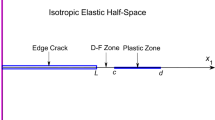Abstract
A static crack front deviates more and more from straight line in a solid as I. the number of dislocations generated from the crack front increases and/or II. the temperature increases. The significance of these deviations into the plane perpendicular to the crack propagation direction is the subject of the present study, which we divide into two parts. In this paper (Part I), the influence of dislocation generation on the shape of a static crack front and on the conditions for crack motion are investigated. We have considered an elastic-plastic crack model in which, due to dislocation generation during mode I loading, the initially straight crack front deviates in the sinusoidal form in a plane perpendicular to both the average crack plane and the direction of fracture propagation. No crack opening displacement is allowed. The dislocations generated form a plastic zone separated from the crack by a dislocation free zone. Both the crack and the plastic zone are described in terms of continuous distributions of dislocations that are sinusoidal and straight edges, respectively. Expressions for the dislocation distributions, the relative displacement of the faces of the crack, the number of dislocations in the plastic region, and the crack opening force G per unit length of the crack front are evaluated. The similarities with isolated cracks (planar and wavy) are emphasized. It is shown that the stress at the front of the sinusoidal crack is unbounded in the mean fracture plane but bounded outside. Consequently, only the crack front sites located on the average crack plane are possible sites for the initiation of crack motion. G differs from that of the planar crack by a geometrical factor that depends on a new parameter, the crack front inclination angle θ. This is an acute angle, measured in the plane perpendicular to the crack propagation direction, between the crack front and the average fracture plane. As θ increases with the number of dislocations generated, G decreases and is ultimately zero for a critical value θc=tan −1(1/sqrtν) where ν is the Poisson ratio. This is a new condition for crack arrest in solids. Applying the theory to a steel, it is found that this condition could be achieved under localized plastic yielding at crack tips.
Similar content being viewed by others
References
Anongba, P.N.B. (1995). The displacement and stress fields due to a sinusoidal edge dislocation. Physica Status Solidi B190, 135-149.
Anongba, P.N.B. (1996). A non-planar crack analysis using continuously distributed sinusoidal edge dislocations and linear elasticity. Physica Status Solidi B194, 443-452.
Anongba, P.N.B. (2003). Significance of the deviations of the crack front into the plane perpendicular to the crack propagation direction. Part II. Crack-front vibration. International Journal of Eracture, submitted.
Bilby, B.A., Cottrell, A.H. and Swinden, K.H. (1963). The spread of plastic yield from a notch. Proceedings, Royal Society London A272, 304-314.
Bilby, B.A. and Swinden, K.H. (1965). Representation of plasticity at notches by linear dislocation arrays. Proceedings, Royal Society London A285, 22-33.
Bilby, B.A. and Eshelby, J.D. (1968). Dislocations and the theory of fracture. In: Fracture (Edited by H. Liebowitz), Vol. 1, Academic Press, New York, 99-182.
Chang, S.-J. and Ohr, S.M. (1981). Dislocation free zone model of fracture. Journal of Applied Physics 52, 7174-7181.
Chang, S.-J. and Ohr, S.M. (1982). Dislocation-free zone model of fracture comparison with experiments. Journal of Applied Physics 53, 5645-5651.
Chang, S.-J. and Ohr, S.M. (1983). Distribution function of dislocations and condition of finite stress for the dislocation-free zone model of fracture. International Journal of Fracture 23, R3-R6.
Dugdale, D.S. (1960). Yielding of steel sheets containing slits. Journal of the Mechanics and Physics of Solids 8, 100-104.
George, A. and Michot, G. (1993). Dislocation loops at crack tips: nucleation and growth-an experimental study in silicon. Materials Science and Engineering A164, 118-134.
Gradshteyn, I.S. and Ryzhik, I.M. (1980). Table of Integrals, Series, and Products, Academic Press, New York.
Henshall, J.L., Rowcliffe, D.J. and Edington, J.W. (1977). Fracture toughness of single-crystal silicon carbide. Journal of the Americal Ceramic Society 60, 373-375.
Hull, D., Beardmore, P. and Valintine, A.P. (1965). Crack propagation in single crystals of tungsten. Philosophical Magazine 12, 1021-1041.
Irwin, G.R. (1957). Analysis of stresses and strains near the end of a crack traversing a plate. Journal of Applied Mechanics 24, 361-364.
Muskhelishvili, N.I. (1953). Singular Integral Equations, Noordhoff, Groningen.
Ohr, S.M. (1985). An electron microscope study of crack tip deformation and its impact on the dislocation theory of fracture. Materials Science and Engineering 72, 1-35.
Rice, J.R. and Thomson, R. (1974). Ductile versus brittle behavior of crystals. Philosophical Magazine 29, 73-96.
Samuels, J. and Roberts, S.G. (1989). The brittle-ductile transition in silicon. I. Experiments. Proceedings, Royal Society London A421, 1-23.
Smithells, C.J. (1992). Smithells Metals Reference Book, Butterworth-Heinemann, Oxford.
Thomson, R. (1986). Physics of fracture. In: Solids State Physics (Edited by H. Ehrenreich and D. Turnbull), Vol. 39, Academic Press, Orlando, 1-129.
Weertman, J. (1978). Fracture mechanics: A unified view for Griffith-Irwin-Orowan cracks. Acta Metallurgica 26, 1731-1738.
Author information
Authors and Affiliations
Corresponding author
Rights and permissions
About this article
Cite this article
Anongba, P., Vitek, V. Significance of the deviations of the crack front into the plane perpendicular to the crack propagation direction - I. Crack-front dislocation generation. International Journal of Fracture 124, 1–15 (2003). https://doi.org/10.1023/B:FRAC.0000009303.95683.81
Issue Date:
DOI: https://doi.org/10.1023/B:FRAC.0000009303.95683.81




